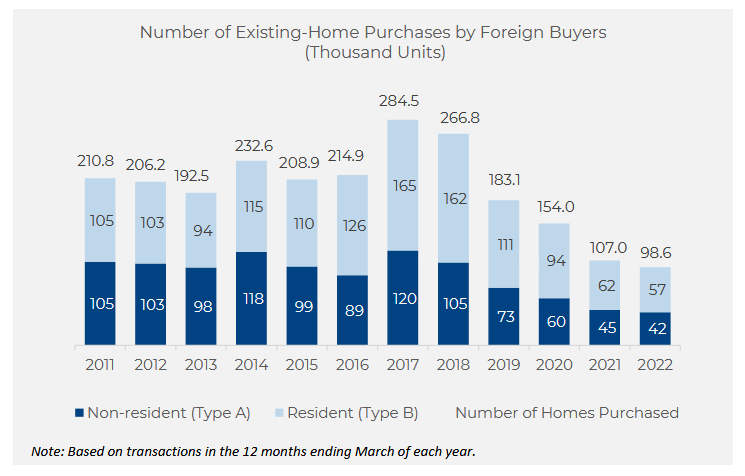International homebuyers, whose home country is not the U.S., bought over than $59 billion of U.S. properties in the 12 months from April 2021 to March 2022, according to the National Association of Realtors, a Chicago-based trade group.
In the comparable prior 12-month period, that figure was $54.4 billion, the NAR said.
Which nations are buying the most?
Six nations accounted for approximately 36 percent of all reported international transactions in the last year:
- Canada
- Mexico
- China
- India
- Brazil
- Colombia
Canada commanded the largest share in terms of transaction volume at 11 percent, while China, defined as The People's Republic of China, Hong Kong and Taiwan, accounted for the biggest dollar volume at $6.1 billion or 6 percent. Mexico accounted for 8 percent, while India accounted for 5 percent. Brazil and Columbia tallied 3 percent each.
Where are they buying?
International buyers and recent immigrants buy homes throughout the U.S., but six states accounted for 58 percent of the total reported purchases by foreigner buyers:
- Florida: 24 percent
- California: 11 percent
- Texas: 8 percent
- Arizona: 7 percent
- New York: 4 percent
- North Carolina: 4 percent
Broken out by choice, Florida was the preferred destination of buyers from Canada, Columbia and Brazil; California was the first choice of homebuyers from China and India, and Texas was the top selection of those from Mexico.
 (Source: "Profile of International Transactions in U.S. Residential Real Estate" Copyright National Association of REALTORS®.)
(Source: "Profile of International Transactions in U.S. Residential Real Estate" Copyright National Association of REALTORS®.)
International buyers considered proximity to their home country, presence of friends and family, job and educational opportunities and climate when they purchase U.S. real estate, the NAR said.
On average, a bit more than half of foreign buyers from the top six originating countries chose a suburban area for their purchase. Just slightly less than one-quarter chose a central city or urban area and about 19 percent chose a small town or rural area. The remaining fraction bought homes in resort areas, but these purchases were concentrated among buyers from Canada, Mexico and China.
It's not unusual to find concentrations of people grouped by nationality within pockets inside individual states. That suggests "word-of-mouth and shared experiences influence purchases," the NAR said.
Why foreigners are buying U.S. real estate
"Foreign buyers are being enticed to U.S. real estate because of what they recognize as attractive prices, economic stability, and an incredible opportunity for investment in their future," said Steve Brown, NAR president and co-owner of Irongate Realtors in Dayton, Ohio.
The challenges of the housing market likely also vexed foreign buyers as much as domestic ones. Fifty-seven percent of foreign buyers reported not being able to find a suitable property to buy, up from 46% in 2021.
“Favorable exchange rates, affordable home prices and rising affluence abroad continue to drive international buyers to the U.S. to purchase properties and make real estate investments,” said the NAR.
International buyers are more likely to pay cash (approximately 44 percent) in part because they often don't have a U.S.-based credit history or Social Security number and their financial profiles differ from those of domestic buyers. Even though mortgage rates are still relatively low, paying cash gives foreign buyers an advantage in any market where other purchasers are forced to rely on financing.
With COVID-19 restrictions easing this year and travel in an upsurge, it's expected that purchases by international buyers will pick up again. In dollar terms, $59 billion in sales to this audience was recorded in the April 2021-March 2022 period, up from $54.4 billion in 2021. However, this increase was due to higher home prices and buyers selecting somewhat more expensive properties; actual unit sales of houses slipped from 107,000 in the 2020-2021 period to 98,600 in the 2021-2022 time frame. In the latest year, international buyers still only accounted for 1.6 percent of all existing sales and 2.6% of the dollar volume, down from 1.8% of total home sales (and 2.8% of the dollar volume) in 2021. For the pre-COVID 2019 survey, these figures were 3% and 5% respectively, so there's plenty of recovery yet to go.
This article was updated by Keith Gumbinger.



